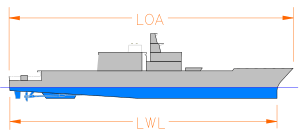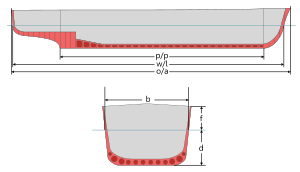Length overall facts for kids
Length overall (often called LOA) is the longest measurement of a boat or ship. It measures the total length of the vessel's main body, called the hull. This measurement is taken from the very front (bow) to the very back (stern). It's measured in a straight line, parallel to the water.
LOA is super important for many reasons. For example, when a ship needs to dock in a marina, the harbor master needs to know its LOA. This helps them find a spot big enough for the ship. Marinas also often charge money based on a boat's LOA. So, a longer boat might cost more to park!
Sometimes, for sailing ships, the LOA might not include parts that stick out from the hull. Things like a bowsprit (a pole sticking out from the front) might be left out. This can be a bit confusing because some people include them, and others don't. Other names like "sparred length" or "total length including bowsprit" are sometimes used to be clearer.
What is Length on Deck (LOD)?
The Length on Deck (or LOD) is another way to measure a vessel. It focuses only on the length of the main deck. This measurement is useful because it tells you the length of the hull itself. It does not include any parts that stick out, like a bowsprit. For smaller sailing boats, the LOD can be quite different from the LOA. This is because their bowsprits can be very long compared to the boat's hull.
What is Length of Hull (LOH)?
The Length of Hull (or LOH) is a term used for small boats. It's defined by the ISO 8666 rules. LOH measures only the length of the boat's hull. It specifically leaves out any parts that are attached to the hull but are not part of the main body. This includes things like bowsprits or other fittings. So, a boat's LOH might be shorter than its LOA.
What is Waterline Length (LWL)?
Another important measurement is the Waterline Length (or LWL). This is the length of the boat where it sits in the water. Imagine a line around the boat where the water touches it when the boat is loaded normally. The LWL is the length of that line. LWL is very useful for figuring out how fast a boat might go. It also helps naval architects design efficient hulls. For older yachts or boats with long bowsprits, the LWL can be much shorter than the LOA.
See also
 In Spanish: Eslora para niños
In Spanish: Eslora para niños
- The National Register of Historic Vessels
- Length between perpendiculars



